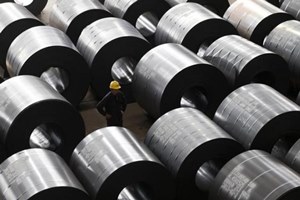During FY93 to FY02 (post reform period) the manufacturing growth had maintained steel-elasticity of 0.91. However, in the next decade and half (FY03 to FY16) steel-manufacturing elasticity dropped down to 0.57. Under manufacturing, the steel-intensive segments comprising fabricated metals, basic metals, motor vehicles, machinery and equipment, electrical equipment, other transport and furniture manufacturing are identified and together it holds a 38% share in manufacturing. The manufacturing sector has been experiencing a near stagnant growth in the past few years having clocked a (-)0.8% growth in 2013-14, followed by 2.3% growth in 2014-15 and ending with 2% growth in last year.
In the first two months of the current fiscal, manufacturing has seen a growth of 3.7% over last year. With the current subdued growth in manufacturing and the average steel-manufacturing elasticity, steel consumption by the manufacturing sector grows at a poor rate of 2.4% which is much lower than its potential. The country is earnestly hoping that with successful launching of Make in India programme and relaxation announced in FDI inflows in defence equipment, civil aviation and shipbuilding, there would be more investment flowing in manufacturing and Indian manufacturers would step in to make India a hub of manufacturing with adequate FDI coming in to meet the resource funding. The rising enthusiasm by which multinational auto manufacturers are setting up new facilities, service centres in the vicinity of major consumption points is a real testimony of boosting the demand for Indian manufacturing base.
The weakest links in manufacturing is provided by capital goods industry which is languishing at (-) 3.6% in FY14, followed by 6.4% growth in FY15 and ending with (-) 2.9% growth in FY16. This segment has one of the highest steel intensity unlike in consumer durable segment that has grown by a respectable 11.3% in FY16, up from (-) 12.6% growth in FY15. In the first two months in current year while capital goods have grown by 9.3%, the consumer durable segment has risen by (-) 2.5%. The impact on slow growth in demand for steel is obvious.
It is high time that Indian manufacturing regains its previous phase of glory in expanding the engineering exports significantly and restore its glory as in the past. It is heartening to note that the government is very keen to provide the level playing field to Indian manufacturing sector so that its share in GDP rises from the current 16-17% to 20% in the minimum by the next few years. The pre-fabricated structures which are showing an impressive acceptance in the market and increasingly demanded by various construction segments would also provide a big push to the health of manufacturing sector. This development would usher in a healthy growth of steel demand especially in cold formed structurals and coated sheets. The rise in demand for pre-fabricated structures justifies the clear interdependence of construction and manufacturing sectors.
There is another inhibiting factor that is likely to emerge as a most constraining element in the growth of pre-fabricated structures in the domestic market and it relates to dearth of competent fabricators who are able to follow the standard good practices and provide defect free and elegant fabrication. The excise duties imposed on shop fabricated outputs with site fabrication being exempted from payment of duties make the former a costlier input and less takers.
By its very nature and processes, the steel requirement by site fabrication is lower than shop fabrication that generally follows standard procedures. It is necessary to encourage shop fabrication and incentivise the fabricators in the interest of quality fabrication and this would go a long way to improve the quality of construction of structures, its elegance and aesthetics.
Manufacturing growth is an essential pre-requisite for steel consumption growth. In the last three years the push from manufacturing was at its lowest. On other characteristics like productivity, employment potential, export orientation, the role of manufacturing is declining. A reversal of the down turn in manufacturing would only be strengthening steel demand by forging steel-intensive manufacturing in various sub-segments.
The author is DG, Institute of Steel Growth and
Development. Views expressed are personal.


